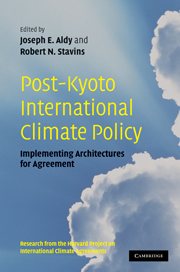Book contents
- Frontmatter
- Contents
- Harvard Environmental Economics Program, International Advisory Board
- Harvard Project on International Climate Agreements, Faculty Steering Committee
- Harvard Project on International Climate Agreements, Project Management
- List of figures
- List of tables
- List of contributors
- Foreword
- 1 Introduction
- Part I Alternative international policy architectures
- Part II Negotiation, assessment, and compliance
- 9 How to negotiate and update climate agreements
- 10 Metrics for evaluating policy commitments in a fragmented world: the challenges of equity and integrity
- 11 Justice and climate change: the unpersuasive case for per capita allocations of emissions rights
- 12 Toward a post-Kyoto climate change architecture: a political analysis
- Part III The role and means of technology transfer
- Part IV Global climate policy and international trade
- Part V Economic development, adaptation, and deforestation
- Part VI Modeling impacts of alternative allocations of responsibility
- Part VII Synthesis and conclusion
- Appendix A Selected List of Individuals Consulted, Harvard Project on International Climate Agreements
- Appendix B Workshops and Conferences, Harvard Project on International Climate Agreements
- Glossary and Abbreviations
- Index
12 - Toward a post-Kyoto climate change architecture: a political analysis
Published online by Cambridge University Press: 05 June 2012
- Frontmatter
- Contents
- Harvard Environmental Economics Program, International Advisory Board
- Harvard Project on International Climate Agreements, Faculty Steering Committee
- Harvard Project on International Climate Agreements, Project Management
- List of figures
- List of tables
- List of contributors
- Foreword
- 1 Introduction
- Part I Alternative international policy architectures
- Part II Negotiation, assessment, and compliance
- 9 How to negotiate and update climate agreements
- 10 Metrics for evaluating policy commitments in a fragmented world: the challenges of equity and integrity
- 11 Justice and climate change: the unpersuasive case for per capita allocations of emissions rights
- 12 Toward a post-Kyoto climate change architecture: a political analysis
- Part III The role and means of technology transfer
- Part IV Global climate policy and international trade
- Part V Economic development, adaptation, and deforestation
- Part VI Modeling impacts of alternative allocations of responsibility
- Part VII Synthesis and conclusion
- Appendix A Selected List of Individuals Consulted, Harvard Project on International Climate Agreements
- Appendix B Workshops and Conferences, Harvard Project on International Climate Agreements
- Glossary and Abbreviations
- Index
Summary
Reports of the Intergovernmental Panel on Climate Change (IPCC) make it clear that the risks of global climate change are even greater than previously realized. Yet commensurate progress in negotiating a meaningful future agreement remains elusive. Since maintenance of a stable climate is a public good, both theory and history suggest it will be undersupplied. Furthermore, the costs of climate change will largely fall on politically weak developing countries, whereas the costs of emissions reduction will largely fall on industrialized countries. Consequently, agreement on any meaningful international regulatory system has been and will continue to be very difficult. With the 1997 Kyoto Protocol coming to an end in 2012, however, the design of a new regulatory regime is essential.
Any international regime aimed at the mitigation of climate change must solve three problems: (1) secure sufficient participation to be effective; (2) achieve agreement on rules that are meaningful, so that if they were followed, climate change would indeed be mitigated; and (3) ensure compliance with the rules. That is, it must solve problems of participation, effectiveness, and compliance. Solving all three problems simultaneously is particularly difficult, since these goals are often in tension. The most direct trade-off is between participation and the strictness of the rules, since as rules become stricter, reluctant states become even more reluctant to be bound by them. Similarly, as participation becomes wider, agreement may only become possible on lax rules.
- Type
- Chapter
- Information
- Post-Kyoto International Climate PolicyImplementing Architectures for Agreement, pp. 372 - 400Publisher: Cambridge University PressPrint publication year: 2009
- 6
- Cited by



